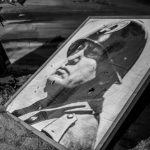 Creepy
Creepy  Creepy
Creepy  Technology
Technology 10 Scientific Breakthroughs of 2025 That’ll Change Everything
 Our World
Our World 10 Ways Icelandic Culture Makes Other Countries Look Boring
 Misconceptions
Misconceptions 10 Common Misconceptions About the Victorian Era
 Mysteries
Mysteries 10 Strange Unexplained Mysteries of 2025
 Miscellaneous
Miscellaneous 10 of History’s Most Bell-Ringing Finishing Moves
 History
History 10 Great Escapes That Ended Right Back in Captivity
 Weird Stuff
Weird Stuff 10 Fascinating Things You Might Not Know About Spiders
 Food
Food 10 Everyday Foods You Didn’t Know Were Invented by the U.S. Military
 History
History 10 Odd Things Colonial Americans Kept at Home
 Creepy
Creepy 10 More Representations of Death from Myth, Legend, and Folktale
 Technology
Technology 10 Scientific Breakthroughs of 2025 That’ll Change Everything
 Our World
Our World 10 Ways Icelandic Culture Makes Other Countries Look Boring
Who's Behind Listverse?

Jamie Frater
Head Editor
Jamie founded Listverse due to an insatiable desire to share fascinating, obscure, and bizarre facts. He has been a guest speaker on numerous national radio and television stations and is a five time published author.
More About Us Misconceptions
Misconceptions 10 Common Misconceptions About the Victorian Era
 Mysteries
Mysteries 10 Strange Unexplained Mysteries of 2025
 Miscellaneous
Miscellaneous 10 of History’s Most Bell-Ringing Finishing Moves
 History
History 10 Great Escapes That Ended Right Back in Captivity
 Weird Stuff
Weird Stuff 10 Fascinating Things You Might Not Know About Spiders
 Food
Food 10 Everyday Foods You Didn’t Know Were Invented by the U.S. Military
 History
History 10 Odd Things Colonial Americans Kept at Home
10 Stories That Hit the Headlines 60 Years Ago in 1965
What a year 1965 was. America’s Civil Rights campaigns intensified while the Vietnam War’s escalation accelerated. Notable people, from Sir Winston Churchill to Malcolm X, breathed their last, and a deadly outbreak of tornadoes ravaged the Midwest. However, it wasn’t all doom and gloom that year, which also saw some memorable movie releases and a healthy output of great music from artists like The Beatles, The Rolling Stones, and Bob Dylan. Read on for details about stories that made the news in 1965.
Related: 10 World Events That Made the News a Century Ago in 1925
10 Canadian Pacific Flight 21: A Tragic Mystery
On a July day, Canadian Pacific Flight 21 took off from Vancouver on a flight to Whitehorse in the Yukon, with various stopovers scheduled for the journey. The four-propeller Douglas DC-6B, grandly called “Empress of Buenos Aires,” flew toward its first stop-off at Whitehorse carrying 46 passengers and six crew. This leg of the flight was due to take 90 minutes, but after about an hour, the crew made a mayday call before the aircraft disappeared from radar.
Witnesses later reported a violent explosion that broke the plane apart and was followed by its uncontrolled descent into forest. Rescuers came upon a scene of devastation and made the grim discovery that all 52 aboard had perished.
So what had happened? Investigators confirmed what witnesses had seen—the plane had been destroyed by an explosion in midair. They were able to pinpoint the blast to a toilet at the back of the plane caused by a bomb. Although analysts identified bomb fragments, they found no timer and concluded that someone had taken the bomb aboard and deliberately detonated it. But despite exhaustive inquiries into the backgrounds of everyone on the flight, neither the perpetrator nor a motive has ever been identified.[1]
9 Vietnam War Escalates
During 1965, America’s involvement in the Vietnam War accelerated at pace. In March, 3,500 U.S. Marines arrived in South Vietnam. Although there had already been numbers of U.S. military advisors in the country, the Marines were the first combat troops to be deployed. In July, President Lyndon B. Johnson announced that 50,000 additional troops would be deployed, and the monthly draft would increase from 17,000 to 35,000. By the year’s end, there were 180,000 American soldiers in Vietnam.
March had also seen the launch of Operation Rolling Thunder, the aerial bombing of targets in Communist North Vietnam. It was a campaign that would last for nearly four years. Originally, the aim of the bombing was to destroy the Communists’ arms factories, forcing them to cease action against South Vietnam. But despite heavy losses caused by the 846,000 tons of bombs dropped by the U.S. Air Force, the Communists fought on until their victory came a decade later.[2]
8 Folk Purists Flip Out
It’s difficult now to understand the unbridled rage that some folks felt when Bob Dylan first played in public using an electric guitar instead of an acoustic. The guitar was a Sunburst Fender Stratocaster, and the event was the 1965 Newport Folk Festival. The outrage came from folk music purists who met Dylan’s performance—backed by a band with electric instruments as well as his own—with boos and yells of “Play folk music!” and “Get rid of the band!”
But the controversy did little to halt Dylan’s march to international fame, which was bolstered by his 1965 hit “Like a Rolling Stone.” And there were other hits that year that are still familiar today. The Rolling Stones, for example, released “(I Can’t Get No) Satisfaction,” while the Beatles hit the charts with “Yesterday” and “Help!” Then there was “Mr. Tambourine Man” from the Byrds, “California Dreamin’” from The Mamas & The Papas… we could go on. Suffice it to say it was a truly vintage year for music.
Bonus fact: The Stratocaster that Dylan used at Newport sold at a Christie’s auction to an anonymous buyer in 2013 for $965,000. You could buy one in 1965 for around $300.[3]
7 Watts Riots
It was high summer when trouble erupted in the Watts neighborhood of Los Angeles. Rioting soon spread to other majority African-American districts of South-Central Los Angeles, and violent disorder would continue for nearly a week. The arrest of 21-year-old Marquette Frye, an African-American, by a white California Highway Patrol officer sparked the rioting. Frye was driving with his brother Ronald and was stopped for suspected DUI. A fracas developed, a crowd gathered, and the trouble kicked off.
Over the course of six days, 34 people lost their lives, another 1,000 or so were injured, and the bill for damage was an estimated $40 million—some $400 million in today’s dollars. In the aftermath, some asserted that the riots had been nothing more than an outbreak of criminality. Others believed that longstanding grievances about heavy-handed policing were to blame. Martin Luther King Jr. asserted, “The economic deprivation, social isolation, inadequate housing, and general despair of thousands of Negroes teeming in Northern and Western ghettos are the ready seeds which give birth to tragic expressions of violence.”[4]
6 Winston Churchill Dies
Particularly for the British, but also for many around the world, the death of Sir Winston Churchill at the age of 90 on January 24, 1965, triggered intense mourning. He, after all, was the man who led the British as the nation stood alone against the aggression of Adolf Hitler. But Churchill had not always been an outstanding character. Indeed, as a child, he’d been regarded as a poor student and had been shuffled into a military career by his aristocratic parents.
But Churchill achieved fame at an early age for his daredevil exploits in South Africa in 1899 at a time when the British Empire was at war with the Boers, white settlers originally from Europe. Churchill was actually working as a journalist when he was captured by the Boers, but a daring escape won him not only freedom but fame. After that, he pursued a political career that had more or less ended in failure when he unexpectedly became British Prime Minister in 1939 and went on to seize his place in history.[5]
5 The Space Race
The 1960s were the heyday of the Space Race between the Americans and the Russians, and 1965 was no exception. It was a year when the Soviet Union took a step ahead of the U.S. The Russian cosmonaut who achieved this was Alexei Arkhipovich Leonov. He was born in Siberia in 1934 and by all accounts was a talented artist, although that’s not what he’s remembered for. In March 1965, Leonov did something no other human ever had. Leaving his buddy Pavel Belyayev to mind the spaceship, he exited and walked in space for 12 minutes.
However, the Americans weren’t too far behind. Just three months later, in June, two NASA astronauts, Edward H. White II and James A. McDivitt, blasted into orbit aboard Gemini IV. As planned, White left the craft to walk in space. And in the spirit of the Space Race, he spent 20 minutes out of his ship, exceeding Leonov’s total. Tragically, White’s life was cut short in 1967 in a fire aboard Apollo 1 during launch pad testing.[6]
4 The Selma March: Bloody Sunday
On March 17, 1965, a day that became known as “Bloody Sunday,” civil rights campaigners planned to march from Selma, Alabama, to the state capital, Montgomery. The background to the protest was the campaign to register Black voters in Selma, the county seat of Dallas County. At the time, only 1 or 2 percent of eligible Black voters were actually registered, disenfranchised by a range of red tape measures calculated to discourage African Americans.
On that fateful Sunday, around 600 marchers set off from the Brown Chapel African Methodist Episcopal Church heading for the Edmund Pettus Bridge, which led out across the Alabama River and onwards to Montgomery. However, at the bridge, they were met by a group of state troopers and sheriff’s deputies, some of whom were mounted. The officers tear-gassed the marchers and attacked them with “billy clubs and bullwhips,” resulting in 50 hospital admissions. The whole conflict was televised, shocking Americans across the nation.
One week later, President Lyndon B. Johnson announced legislation to guarantee voters’ rights, saying, “What happened in Selma is part of a far larger movement which reaches into every section and State of America. It is the effort of American Negroes to secure for themselves the full blessings of American life.”[7]
3 “The Hills Are Alive…”
What those hills were alive with was, of course, 1965’s most successful movie, The Sound of Music. The film won five Oscars, including Best Picture, and was the highest-grossing movie at the time, as well as the first to surpass $1 million at the box office. Not bad for a film that cost just $8.2 million to make. Just how many Americans have seen The Sound of Music? It would probably be easier to count those who haven’t seen this evergreen classic.
But Julie Andrews’s Alpine tour de force was not the only memorable movie made that year. There was the sprawling Russian Revolution epic with its heartbreaking love story of Lara (Julie Christie) and Yuri (Omar Sharif), Dr. Zhivago. It was the second highest-grossing film of 1965.
Then there was the second of Sergio Leone’s spaghetti western trilogy, For a Few Dollars More. Who could forget the cooler-than-ice Clint Eastwood, Klaus Kinski’s sinister hunchback, or Ennio Morricone’s haunting soundtrack?
An English pop group called the Beatles also put out a film, Help!, and Scottish actor Sean Connery made his fourth outing as James Bond in Thunderball.[8]
2 Palm Sunday Tornadoes
It was on April 11, 1965, that an extraordinary sequence of tornadoes blighted America’s Midwest, bringing death and destruction to six states. The catastrophic event came on Palm Sunday, the Sunday before Easter, and took its name from the Christian festival. Indiana was the worst hit of the states devastated by what was the fourth worst recorded outbreak of tornadoes in the U.S. It was the worst-ever tornado event in Indiana’s history, with 137 people losing their lives.
The other five states that endured a total of 55 tornadoes that day were Illinois, Iowa, Michigan, Ohio, and Wisconsin. Eighteen of those tornadoes were classified as F4 in strength, meaning they generated wind speeds as high as 260 miles per hour. At the time, the estimated cost of the damage was $250 million—more than $2.5 billion in 2025 dollars. The final death toll was a grim 270, with thousands more injured.[9]
1 Malcolm X
It’s late on February 21, 1965, at the Audubon Ballroom in New York’s Harlem, and controversial Black Power advocate Malcolm X is about to address an audience of 400. But before he can start his speech, three men jump up and start shooting at him. His 21 gunshot wounds are fatal, and he dies on the stage in front of his pregnant wife, Betty Shabazz, and their three young children.
Three men, all members of the Nation of Islam, were arrested, charged, and convicted of Malcolm X’s murder, but that was far from the end of the affair. The accepted story at the time was that the militant Nation of Islam had been behind the killing. Malcolm had been a prominent member until the year before his death but had left after a bitter dispute with the Nation’s leader, Elijah Muhammad. After he left, Malcolm received death threats, and the night before his murder, his home was firebombed.
Controversy about Malcolm’s assassination rumbled on for decades. In 2021, two of the men convicted of the murder were exonerated and received $36 million in compensation.[10]








